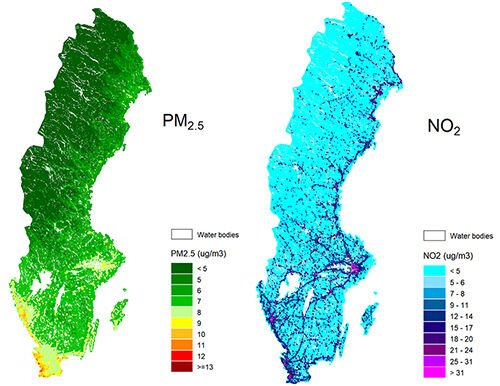The IMM ambient exposome database
The Institute of Environmental Medicine (IMM) together with the Center for Occupational and Environmental Medicine (CAMM) have developed methods to assess individual exposure to various environmental factors. These include air pollution, transportation noise, green/blue spaces and temperature which have been combined with other data on an individual or population level.

The rich environmental data are stored within the IMM ambient exposome database. This source of environmental exposure information is available for research and risk assessment for academic and industry-based researchers or other public bodies. Please read more below what is required to initiate research using the IMM ambient exposome database. A comprehensive overview of the data available can be found in the IMM application document.
Policy and conditions
The exposure estimation can be used within the framework of epidemiological investigations of relationships between environmental factors and different health outcomes, and for risk assessment at the population level. The applicant must have a PhD, if not, please provide a collaborator with a PhD. The IMM Ambient Exposome database (A-EDB) Review Committee meets four times per year and decides on all requests.
To process your request, a complete application must be received by the Review Committee no later than one week before a scheduled Committee. For more information, please contact us by e-mail to exposome-imm@ki.se.
Dates for the Review committee meetings in fall 2025
- 24/09/2024 (deadline to apply before the meeting is 17/09/2024)
- 06/11/2024 (deadline to apply before the meeting is 30/10/2024)
How to apply?
To be completed, the application must contain the following:
Step 1: download the data request - IMM Exposome database template
Step 2: prepare documents
- Fill out the data request template. The applicant will need to provide a description of the project including:
- applicant information
- specific aims
- general background
- methods and statistical analyses
- requested exposure variables
- Prepare 2-page CV
Step 3: send the data request and CV to exposome-imm@ki.se
Step 4: after approval. Upon approval, both parties (IMM and the applicant) sign a Data Transfer Agreement. The applicant will be contacted for further steps and provided with a timeline.
What data do we need from the applicant?
To apply the environmental data to a study dataset, applicants will need to provide geocoded addresses (typically residential histories) of study participants with the exact latitude and longitude location. Geocoding an address is the process of taking a text-based description of a location, such as an address or the name of a place, and returning the exact latitude and longitude location, to identify a location on the Earth's surface. In the data request form, the applicant will need to specify if the addresses are geocoded and the source of the addresses. The applicant will also need to provide information about the coordinate system and projection they are using. The coordinate system used by the IMM Exposome group is Sweref 99 TM (EPSG 3006).
IMPORTANT: The IMM Exposome group does not provide a service to geocode addresses. However, we can give support and contacts how to geocode and to perform an accurate manual cleaning, which is needed to provide sufficient quality of the geocoding process. Please contact us for further guidance. More information on how to obtain geocoded addresses is found in page 12 of the IMM application document.
